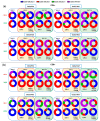Development of a TGFβ-IL-2/15 Switch Receptor for Use in Adoptive Cell Therapy
- PMID: 36830995
- PMCID: PMC9953633
- DOI: 10.3390/biomedicines11020459
Development of a TGFβ-IL-2/15 Switch Receptor for Use in Adoptive Cell Therapy
Abstract
Therapy employing T cells modified with chimeric antigen receptors (CARs) is effective in hematological malignancies but not yet in solid cancers. CAR T cell activity in solid tumors is limited by immunosuppressive factors, including transforming growth factor β (TGFβ). Here, we describe the development of a switch receptor (SwR), in which the extracellular domains of the TGFβ receptor are fused to the intracellular domains from the IL-2/15 receptor. We evaluated the SwR in tandem with two variants of a CAR that we have developed against STEAP1, a protein highly expressed in prostate cancer. The SwR-CAR T cell activity was assessed against a panel of STEAP1+/- prostate cancer cell lines with or without over-expression of TGFβ, or with added TGFβ, by use of flow cytometry cytokine and killing assays, Luminex cytokine profiling, cell counts, and flow cytometry phenotyping. The results showed that the SwR-CAR constructs improved the functionality of CAR T cells in TGFβ-rich environments, as measured by T cell proliferation and survival, cytokine response, and cytotoxicity. In assays with four repeated target-cell stimulations, the SwR-CAR T cells developed an activated effector memory phenotype with retained STEAP1-specific activity. In conclusion, the SwR confers CAR T cells with potent and durable in vitro functionality in TGFβ-rich environments. The SwR may be used as an add-on construct for CAR T cells or other forms of adoptive cell therapy.
Keywords: chimeric antigen receptor; immune suppression; prostate cancer; switch receptor; transforming growth factor β; tumor microenvironment.
Conflict of interest statement
J.A. Kyte, N.P. Casey, C. Beck, and Y. Jin are inventors of patent applications related to the work described in this article.
Figures








Similar articles
-
Comparative Evaluation of STEAP1 Targeting Chimeric Antigen Receptors with Different Costimulatory Domains and Spacers.Int J Mol Sci. 2024 Jan 2;25(1):586. doi: 10.3390/ijms25010586. Int J Mol Sci. 2024. PMID: 38203757 Free PMC article.
-
Development of STEAP1 targeting chimeric antigen receptor for adoptive cell therapy against cancer.Mol Ther Oncolytics. 2022 Jun 22;26:189-206. doi: 10.1016/j.omto.2022.06.007. eCollection 2022 Sep 15. Mol Ther Oncolytics. 2022. PMID: 35860008 Free PMC article.
-
Armored TGFβRIIDN ROR1-CAR T cells reject solid tumors and resist suppression by constitutively-expressed and treatment-induced TGFβ1.J Immunother Cancer. 2024 Apr 12;12(4):e008261. doi: 10.1136/jitc-2023-008261. J Immunother Cancer. 2024. PMID: 38609317 Free PMC article.
-
Chimeric antigen receptor-engineered T-cell therapy for liver cancer.Hepatobiliary Pancreat Dis Int. 2018 Aug;17(4):301-309. doi: 10.1016/j.hbpd.2018.05.005. Epub 2018 May 24. Hepatobiliary Pancreat Dis Int. 2018. PMID: 29861325 Review.
-
The Emergence of Universal Immune Receptor T Cell Therapy for Cancer.Front Oncol. 2019 Mar 26;9:176. doi: 10.3389/fonc.2019.00176. eCollection 2019. Front Oncol. 2019. PMID: 30984613 Free PMC article. Review.
Cited by
-
Shifting the paradigm: engaging multicellular networks for cancer therapy.J Transl Med. 2024 Mar 12;22(1):270. doi: 10.1186/s12967-024-05043-8. J Transl Med. 2024. PMID: 38475820 Free PMC article. Review.
-
Ectopic PU.1 Expression Provides Chimeric Antigen Receptor (CAR) T Cells with Innate Cell Capacities Including IFN-β Release.Cancers (Basel). 2024 Aug 1;16(15):2737. doi: 10.3390/cancers16152737. Cancers (Basel). 2024. PMID: 39123467 Free PMC article.
-
Advances in strategies to improve the immunotherapeutic efficacy of chimeric antigen receptor-T cell therapy for lymphoma.Cancer Biol Med. 2025 Apr 15;22(4):301-21. doi: 10.20892/j.issn.2095-3941.2024.0538. Cancer Biol Med. 2025. PMID: 40231980 Free PMC article. Review.
-
CAR T cells in solid tumors and metastasis: paving the way forward.Cancer Metastasis Rev. 2024 Dec;43(4):1279-1296. doi: 10.1007/s10555-024-10213-7. Epub 2024 Sep 24. Cancer Metastasis Rev. 2024. PMID: 39316265 Review.
-
Comparative Evaluation of STEAP1 Targeting Chimeric Antigen Receptors with Different Costimulatory Domains and Spacers.Int J Mol Sci. 2024 Jan 2;25(1):586. doi: 10.3390/ijms25010586. Int J Mol Sci. 2024. PMID: 38203757 Free PMC article.
References
-
- Martin C.J., Datta A., Littlefield C., Kalra A., Chapron C., Wawersik S., Dagbay K.B., Brueckner C.T., Nikiforov A., Danehy F.T., Jr., et al. Selective inhibition of TGFbeta1 activation overcomes primary resistance to checkpoint blockade therapy by altering tumor immune landscape. Sci. Transl. Med. 2020;12:eaay8456. doi: 10.1126/scitranslmed.aay8456. - DOI - PubMed
Grants and funding
LinkOut - more resources
Full Text Sources
Other Literature Sources

